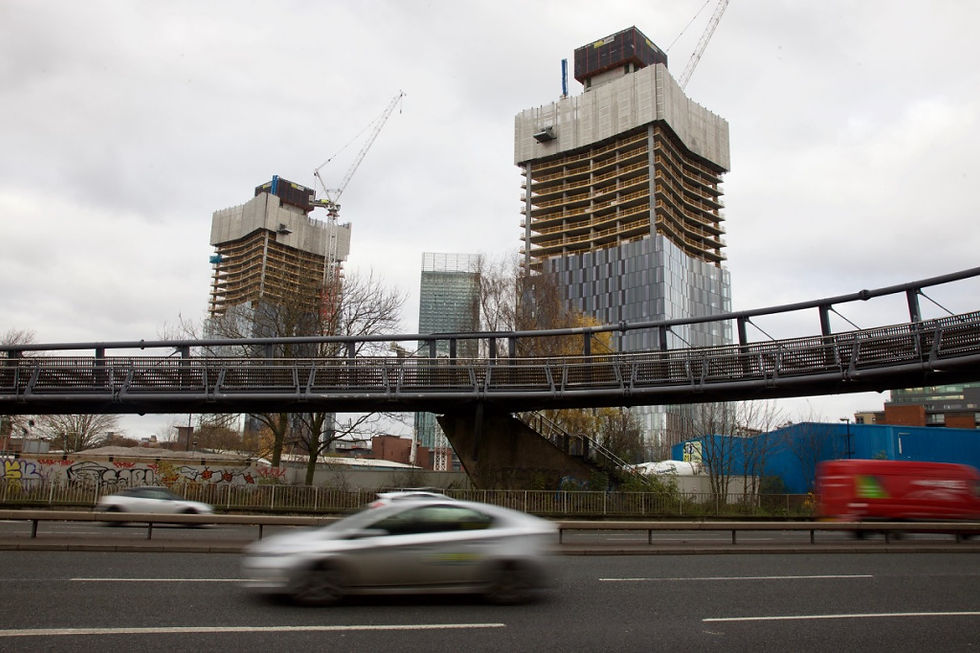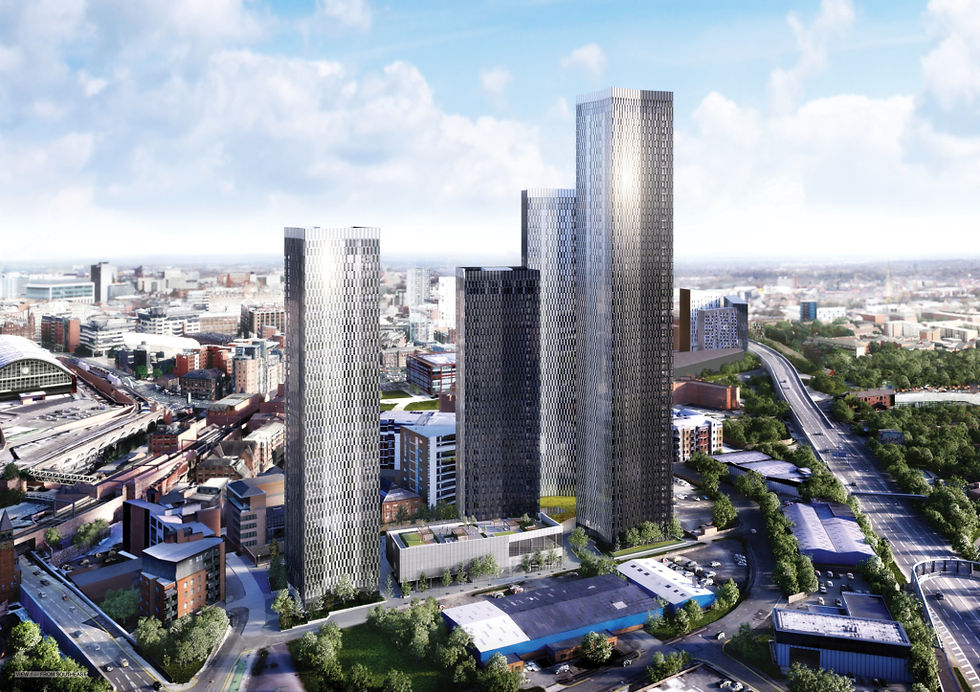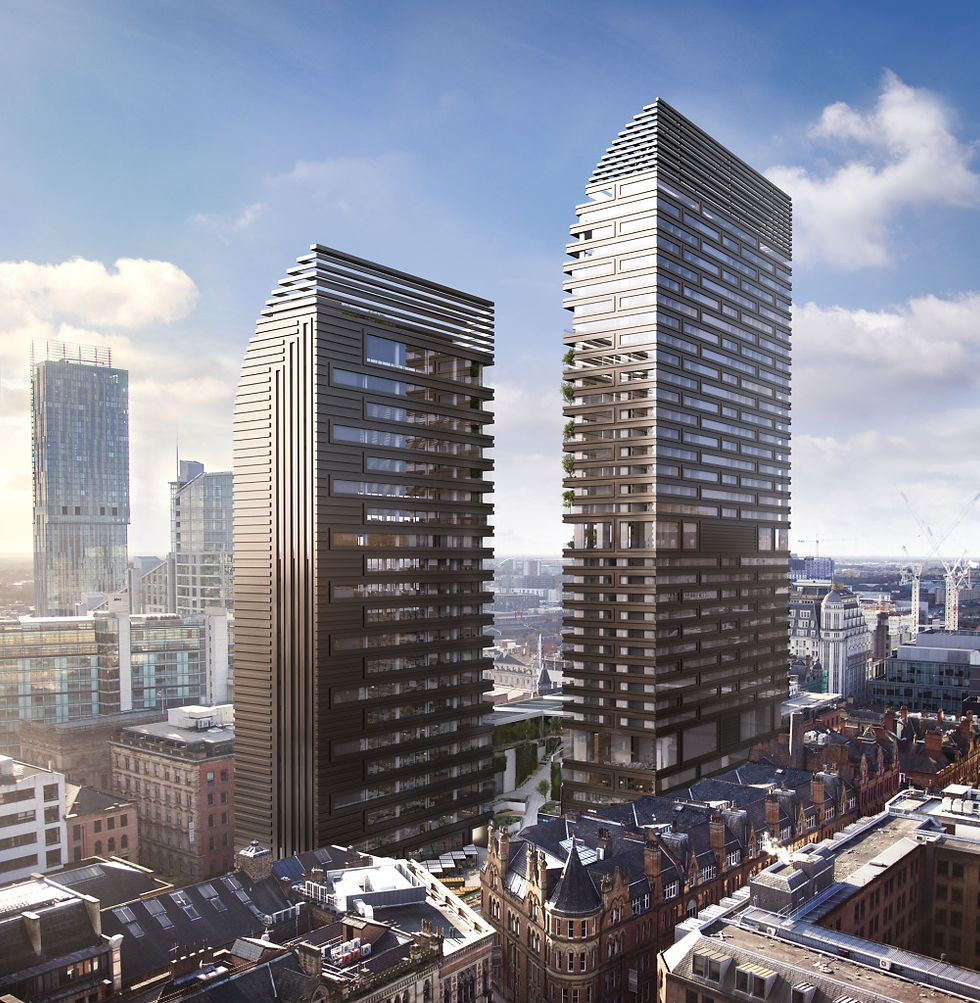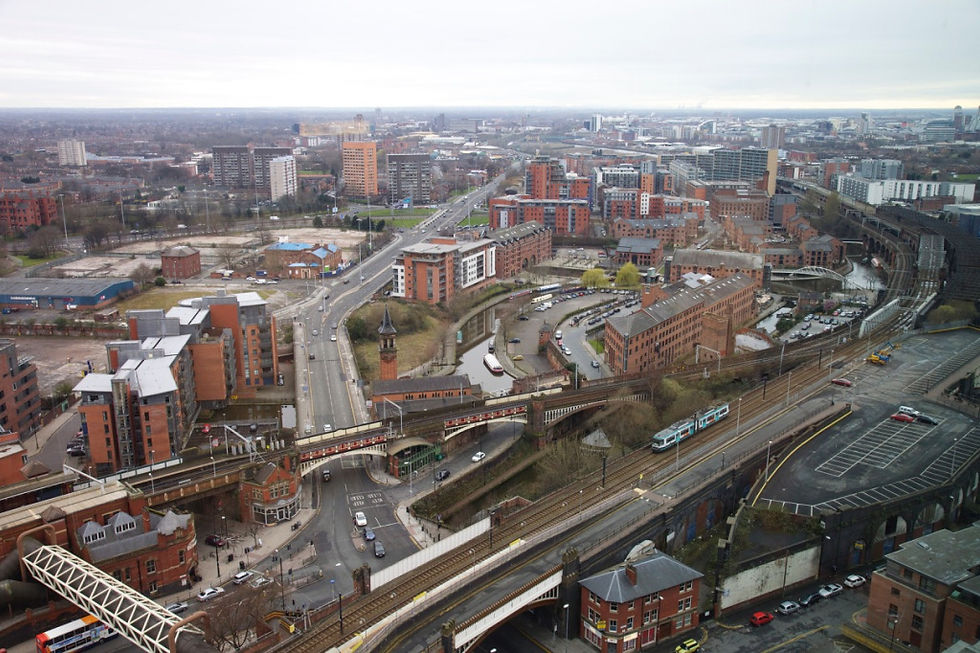Skyscraper deluxe: Manchester’s towers
- Paul Dobraszczyk
- Jan 29, 2018
- 4 min read
Updated: Jun 12, 2020

Towers under construction near the Mancunian Way, Hulme
Manchester, like many other cities today, has a fetish for tall buildings. Perhaps this is a result of the topography of the city centre, occupying, as it does, the bottom of a gently sloping bowl; or, maybe, the natural architectural accompaniment to Manchester being branded as the epicentre of the ‘Northern Powerhouse’. Whatever the reasons, skyscrapers will dominate the city’s skyline in the near future. In 2016, Manchester City Council approved plans for the construction of the 64-storey Owen Street Tower, set to become the second tallest building in the UK after the Shard in London. An even taller tower (67 storeys) will probably soon after overtake the Owen Street Tower, the centrepiece of a five-tower residential island to be built on the banks of the River Irwell, and which was approved by the Council in the summer of 2017.

Architects’ rendering of cluster of towers on Owen Street, currently under construction

Proposed 67-storey tower, designed by Child Graddon Lewis, and to be built at Trinity Islands on the River Irwell by Allied London
Lest we are left wondering what kind of impact these towers will have on the city, the Manchester Evening News has already provided a virtual fly-by to give us an idea. And despite the fact that there seems to be a great deal of public dissatisfaction with these new skyscrapers – witness the withdrawal of ex-footballers Ryan Giggs and Gary Neville’s plan for two bronze towers in the city centre in 2017 after much protest – there seems to be no let up in the City Council’s desire to build tall.

Gary Neville and Ryan Giggs’s proposed bronze skyscrapers, shelved in March 2017
Yet, for the time being, it is the Beetham Tower that remains Manchester’s tallest building. Opened in 2006, its 47 storeys of shimmering glass, housing a luxury hotel and apartments, could not be more different than the defunct Victorian railway viaduct it replaced. Designed by local architect Ian Simpson at a time when Manchester was boldly reasserting itself as a confident competitor to London (and the Beetham Tower remains, for the moment, the tallest building outside the capital), the skyscraper encapsulates the recurrent image of Manchester as a phoenix rising from the ruins of post-industrial decline.

The Beetham Tower, completed in 2006
For those who want to experience the building, and who cannot afford to stay in the 4* Hilton Hotel or to buy the luxury apartments above, there’s always Cloud 23, a restaurant and bar located half-way up that offers spectacular views of the city. Even though this observation deck is much lower than that of the Shard in London (at 72 floors, it’s the highest in the UK), it is still the highest in the city and is thus Manchester’s equivalent to the numerous observation platforms that now grace (and sometimes fund) many of the world’s tallest buildings. In exchange for one overpriced drink, one can see Manchester from an elevated position, the city’s otherwise chaotic networks of roads, railway viaducts and tram lines spread out before you in an orderly fashion, disappearing into the hills beyond. And, at night, that view becomes a fairytale multicolour image of twinkling grandeur: a city that seems to hold you, the viewer, at its very centre. Of course, such a sense of mastery is a product of being so distanced from the chaotic sensory bombardment experienced on the ground and from being hermetically sealed off from the often grey and wet atmosphere just beyond the tall windows. When those other taller skyscrapers are eventually built in Manchester, these feelings will only intensify, with each new building competing to provide the most intense variant on this experience of the city from high above the streets.

View southwest from Cloud 23, towards Castlefield and Stretford

View southwards from Cloud 23 towards Hulme

Beetham Tower and an early 19th-century factory from the Rochdale Canal, Castlefield
However, the Beetham Tower gains a new layer of meaning when viewed from the Rochdale Canal in the Castlefield Basin. For here – the original heartland of Manchester – the otherwise brazenly incongruous form of the skyscraper seems to mirror that of a much older industrial structure, namely, the ruins of a canal-side brick mill dating back to the early nineteenth century that has been miraculously preserved between two railway viaducts. This architectural conversation across time is probably wholly accidental but it nevertheless suggests that the Beetham Tower might actually also be some kind of gigantic ruin; or that it will become one at some point the future – a symbol perhaps of the hidden decay, and inevitable future ruin, that haunts even our most transparent and polished contemporary glass towers.

View of Ian Simpson’s penthouse apartment in the Beetham Tower, as pictured in the Manchester Evening News
As J. G. Ballard powerfully articulated in his 1975 novel High-Rise, skyscrapers may be the epitome of glamour, offering the promise of detachment from the noise, dirt and danger of the city’s streets; yet, their very isolation might lead to the emergence of other, more disturbing problems – in the case of High-Rise, the complete breakdown of civilisation within the skyscraper itself. Perhaps the architect of the Beetham Tower (and its even higher progeny to come, the Owen Street Tower), hasn’t come across Ballard’s novel. For why else would he, like the architect of the eponymous building in High-Rise, choose to live in splendid isolation on the top floor of the skyscraper he himself designed? As Simpson confidently intones: ‘I enjoy the serenity of living at height in a city. The act of rising above it..it’s very secure, no one is going to break in through your window!’ Yet, in Ballard’s novel, after an orgy of violence, the architect of the skyscraper ends up being butchered by the building’s last remaining inhabitants. Of course, Ballard’s vision is extreme, but he uses the doomed skyscraper as a metaphor for the hubris that underlies most high-rise construction. We might believe that we can flee from the dangers of the city by simply rising above them, but we can never escape those that are always lurking within.



Comments